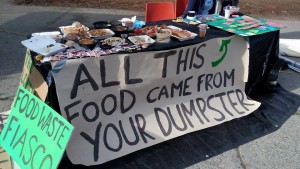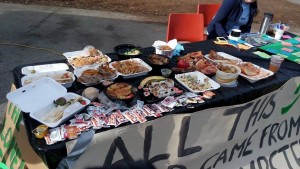Early last month, Common Energy’s Zero Waste team conducted the second annual waste audit of the SUB. Common Energy UBC is an active, student-run organization on the UBC campus devoted to sustainability. The Zero Waste team was created to help promote the “Sort It Out” program that AMS Sustainability has implemented to “decrease the volume of waste sent to landfills, engage campus users through events or activities, and push to make all UBC events zero-waste”. This is all part of AMS Sustainability’s initiatives for a greener UBC campus. I was hoping that the waste audit results would be released by now, but it hasn’t yet so I won’t get to talk about the results. (And much to my dismay, last year’s data can’t be found either!)
Once again this year, they gathered student volunteers for a one-day trash sorting outside the SUB. My sister was one of them. Their role was to sort, weigh, and document a day’s worth of the SUB’s daily waste.
“Each year, AMS operations and businesses produce approximately 400 tons of waste.”
That’s a lot of garbage, and I’m not surprised, with the rate at which I see fellow students throwing perfectly recyclable content and food scraps into the garbage bin. Student waste consumption is a cringe worthy sight, and visibility was the basis for conducting the waste audit outside the SUB. Volunteers were sorting garbage bins right outside the SUB by the North entrance, facing Gage towers, intercepting many students as they passed by to reach the bus loop. This year featured increased foot traffic due to construction of the new aquatic centre blocking off pathways and creating detours around the SUB.
Students were able to see the volunteers at work and the resulting piles of incorrectly sorted waste their peers created. A desk full of unfinished food found in the garbage can sat in the open for all to witness.
How shameful, look at those untouched bowls of rice! Absolutely wasteful of perfectly edible food. If you aren’t going to eat it, at least compost it. This visual representation is a cue to call, an alarm or red flag more like, for students to recognize the impact they create with a single day of waste. Educational booths were also set up for students to learn about this annual waste audit and what they can do to reduce their waste production.
My opinion is that visual representations of the impacts of normalized actions such as throwing away garbage recklessly, driving, leaving lights on and faucets running, and so on, are extremely effective is causing consumers to stop and reassess their actions, yet also working to reaffirm positive behaviour. Hopefully with the new student union building, the Nest, students will be more inclined to keep it looking beautiful with proper trash sorting. No doubt, AMS Sustainability will improve and refine their Sort It Out program based on this year’s waste audit results.
Source(s):


Hi Vivian,
I didn’t even know UBC has a Waste Audit team! They should really market themselves better because I’m sure a ton of people would be interested in helping out, myself included.
Unfortunately I missed the public trash sorting, but luckily your photos provided some great context. Seeing all that wasted food really makes me disappointed with UBC students – you would think that living in a city like Vancouver would teach you not to do things like throw an ENTIRE BANANA into the garbage!
Although I agree with you that our waste habits need to be improved, I don’t think that refining AMS Sustainability’s approach is the most effective way to do it. I believe AMS’ Sort It Out program is doing a great job. Our waste stations are already very informative. They are color coded, have pictures, and even list EXAMPLES of the types of things that go into each compartment. In my opinion, the fault does not lie with AMS Sustainability but rather the uncaring students who choose to ignore the blatant labels. If seeing these tables laden with food doesn’t convince you to attempt composting your food waste, much more drastic measures would be needed to penetrate students’ thick skulls, and these measures may not be kind and enforceable by AMS Sustainability!
One thing that I don’t fault students for however was the large amount of condiment packages. For these, the garbage is likely the correct disposal option because of the non-biodegradeable packaging. Perhaps it’s time to have a chat with A&W about their ketchup packets…
Vincent
Hi Vincent!
Of course, the fault doesn’t lie with AMS Sustainability’s efforts, in fact it’s already wonderful that they are making the effort to “convert” students, but they can try different methodology to alter students’ behaviour and perceptions towards a greener lifestyle both on and off campus. In the end, I believe it’s a background-based issue. “Properly”-raised and well-taught children wouldn’t be so wasteful to the extent of dumping perfectly good food if they were raised not to be grateful for and cherish the things they have. It’s all about education and it’s wonderful that our society is moving forward with that. I hope to see sustainability as a core value of education systems starting as early as elementary school very soon. The key now is to educate the adults who control the system and society.
Hi Vivian!
Thanks for your blog post about this! I actually remember walking by this booth outside the SUB and didn’t even see that huge sign on the table so I was wondering why there were plates and plates of food just sitting there! I actually thought they were giving it out for free (haha!). Now that I know that this was actually food that was thrown away, it’s astonishing to realize that there are so many people at UBC that would waste. I would think we would know better! Definitely agree that because this was so close to home, it’s a clear message to the students about changing behaviours.
Cheers,
Katie